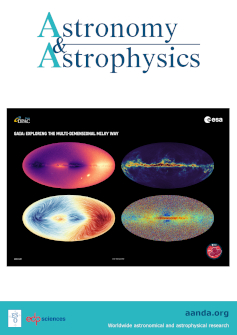富含气体的 "超漫射 "星系符合重子塔利-费舍关系和米尔格罗姆动力学
IF 5.4
2区 物理与天体物理
Q1 ASTRONOMY & ASTROPHYSICS
引用次数: 0
摘要
据报道,一些富含气体的 "超漫射 "星系(UDGs)是低表面亮度(LSB)矮星系的极端例子,它们缺乏暗物质,并且偏离重子塔利-费舍关系(BTFR)。如果得到证实,这些UDGs将对ΛCDM星系形成模型和米尔格罗姆动力学提出严峻挑战。在这里,我将证明由于对倾角和/或距离的不确定性估计不足,这些结论是非常可疑的。首先,我证明了UDGs由于低倾角的系统性偏差,与通常的正面LSB矮星一样偏离了BTFR。接下来,我分析了两颗拥有最佳自转曲线数据的 UDG。第一个UDG(AGC 242019)的倾角非常适合运动学研究;MOND可以拟合观测到的距离为12.5 ± 0.6 Mpc的旋转曲线,这与室女中心流模型是一致的。第二个UDG(AGC 114905)接近正面,因此不是运动学研究的理想对象;MOND可以拟合观测到的距离为68 ± 13 Mpc、倾角为15° ±2°的旋转曲线,这与现有数据一致。我特别指出,由于恒星分布存在明显的不对称性(一边倒),星盘倾角的不确定性比以前估计的要大。总之,没有强有力的证据表明富含气体的UDG和富含气体的LSB矮星系是具有不同动力学性质的不同星系群;相反,UDG似乎是LSB矮星系的一个子集,偏向于正面系统。本文章由计算机程序翻译,如有差异,请以英文原文为准。
Gas-rich “ultra-diffuse” galaxies are consistent with the baryonic Tully–Fisher relation and with Milgromian dynamics
Some gas-rich “ultra-diffuse” galaxies (UDGs), which are extreme examples of low surface brightness (LSB) dwarf galaxies, have been reported to lack dark matter and to be offset from the baryonic Tully–Fisher relation (BTFR). If confirmed, these UDGs would represent a serious challenge for both ΛCDM galaxy-formation models and Milgromian dynamics. Here I demonstrate that these conclusions are very dubious due to underestimated uncertainties on inclinations and/or distances. First, I show that UDGs are offset from the BTFR in the same way as usual face-on LSB dwarfs due to systematic biases at low inclinations. Next, I analyze the two UDGs with the best available rotation-curve data. The first (AGC 242019) is ideally inclined for kinematic studies; MOND can fit the observed rotation curve with a distance of 12.5 ± 0.6 Mpc, which is consistent with Virgocentric flow models. The second UDG (AGC 114905) is close to face-on, so not ideal for kinematic studies; MOND can fit the observed rotation curve with a distance of 68 ± 13 Mpc and inclination of 15° ±2°, which are consistent with existing data. In particular, I show that the disk inclination is more uncertain than previously estimated due to significant asymmetries (lopsidedness) in the stellar distribution. In conclusion, there is no strong evidence that gas-rich UDGs and gas-rich LSB dwarfs are distinct galaxy populations with different dynamical properties; instead, UDGs seem to be a subset of LSB dwarf galaxies biased toward face-on systems.
求助全文
通过发布文献求助,成功后即可免费获取论文全文。
去求助
来源期刊

Astronomy & Astrophysics
地学天文-天文与天体物理
CiteScore
10.20
自引率
27.70%
发文量
2105
审稿时长
1-2 weeks
期刊介绍:
Astronomy & Astrophysics is an international Journal that publishes papers on all aspects of astronomy and astrophysics (theoretical, observational, and instrumental) independently of the techniques used to obtain the results.
 求助内容:
求助内容: 应助结果提醒方式:
应助结果提醒方式:


